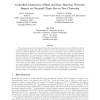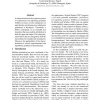455 search results - page 1 / 91 » Using Top Trees For Easy Programming of Tree Algorithms |
DATESO
2009
13 years 2 months ago
2009
Top trees are a dynamic self-adjusting data structure that can be used by any tree algorithm. Actually, an arbitrary number of different tree algorithms can use a single structure....
EMNLP
2010
13 years 1 months ago
2010
We present a new syntactic parser that works left-to-right and top down, thus maintaining a fully-connected parse tree for a few alternative parse hypotheses. All of the commonly ...
AI
2006
Springer
13 years 4 months ago
2006
Springer
This article presents and analyzes algorithms that systematically generate random Bayesian networks of varying difficulty levels, with respect to inference using tree clustering. ...
ACL
2010
13 years 2 months ago
2010
A characterization of the expressive power of synchronous tree-adjoining grammars (STAGs) in terms of tree transducers (or equivalently, synchronous tree substitution grammars) is...
SPAA
2006
ACM
13 years 10 months ago
2006
ACM
Tree contraction algorithms, whose idea was first proposed by Miller and Reif, are important parallel algorithms to implement efficient parallel programs manipulating trees. Desp...


